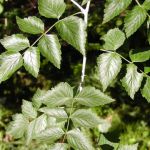| Common Name: |
Chinese Raspberry |
| Botanical Name: |
Rubus coreanus |
| Genus: |
Rubus |
| Family: |
Rosaceae |
| Cultivation: |
Moist, well-drained soil in sun or partial shade. Rubus fruiticosus may be trained on wires or solid surfaces to make harvesting easier. Remove old stems after fruiting. In spring, lightly prune plants grown for fruit. Plants may be damaged by aphids, plant bugs, raspberry beetle, crown gall, Rubus stunt, Botrytis, and virus disease. Rubus fruitcosus is subject to statuatory control as a weed in some countries, notably in parts of Australia. |
| Propagation: |
By seed sown in spring (species only); by softwood cuttings in summer; by leaf-bud cuttings in late summer; by hardwood cuttings in winter; and by tip layering in summer (R. fruiticosus); by root cuttings and suckers during dormancy (R. idaeus); by division in early spring or autumn. |
| Harvest |
Leaves are picked before flowering and dried for use in infusions, liquid extracts, and tablets. Roots are lifted in summer and dried for use in decoctions. Fruits are harvested when ripe and dried for use in decoctions (R. coreanus), or used fresh or frozen for juice, syrups, and culinary purposes. |
| Native Location: |
Korea, Japan, and China |
| Height: |
4m (12ft) |
| Width: |
Indefinite |
| Hardiness |
Z6-9 |
| Parts Used: |
Fruits (fu pen zi) |
| Properties |
An astringent herb that acts as a kidney and liver tonic. |
| Medicinal Uses: |
Internally for complaints associated with disturbed liver and kidney functions, such as urinary dysfunction, premature graying, blurred vision, infertility, impotence, and premature ejaculation. |
| Bibliography: |
Encyclopedia or Herbs ~ Deni Brown ~ copyright ©2005 Dorling Kimbersley Limited. ~ pg 350.
|

